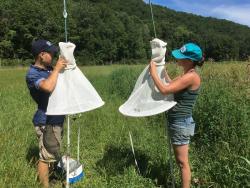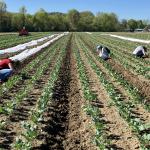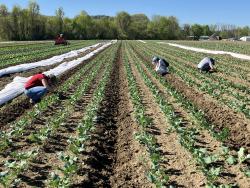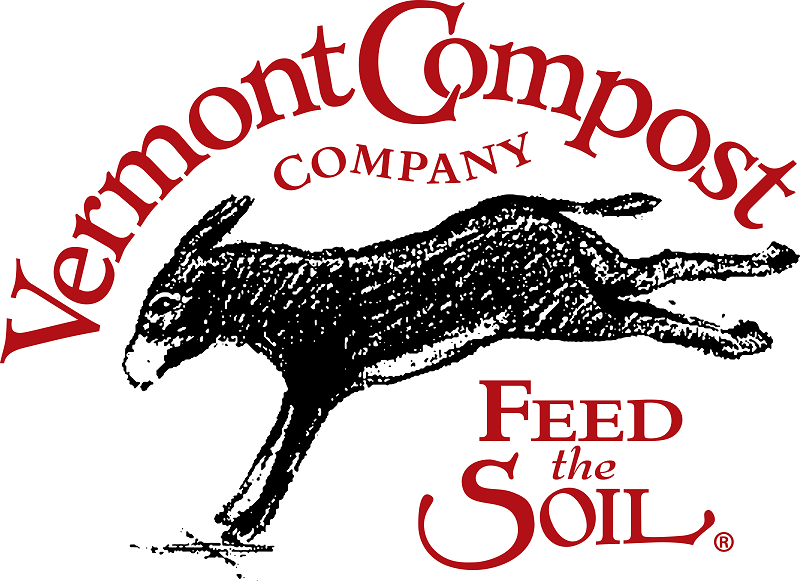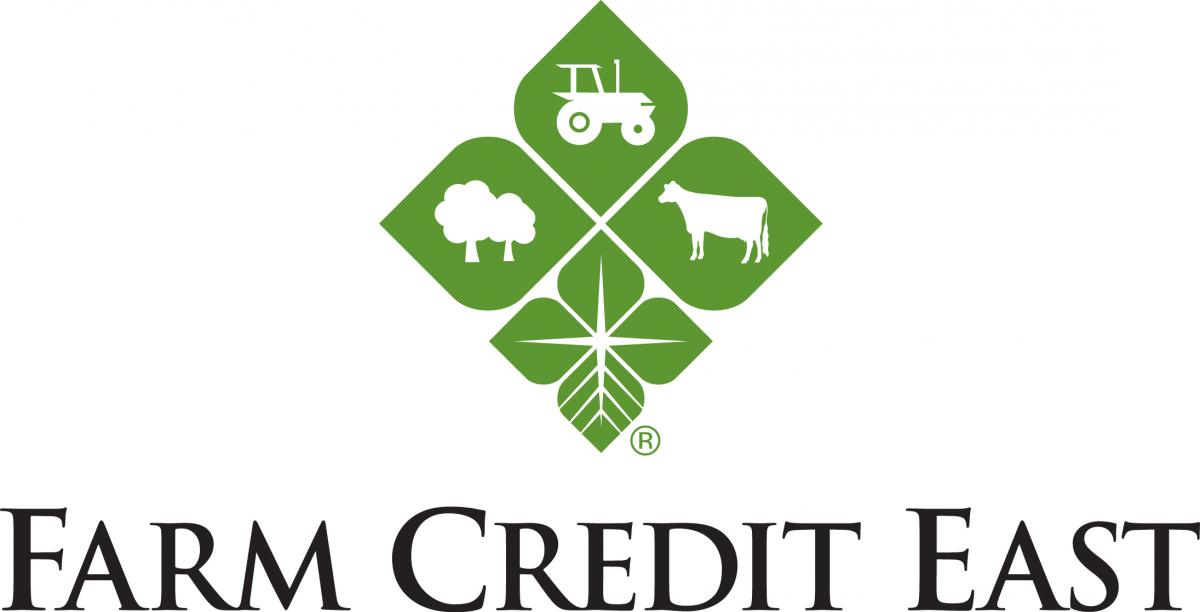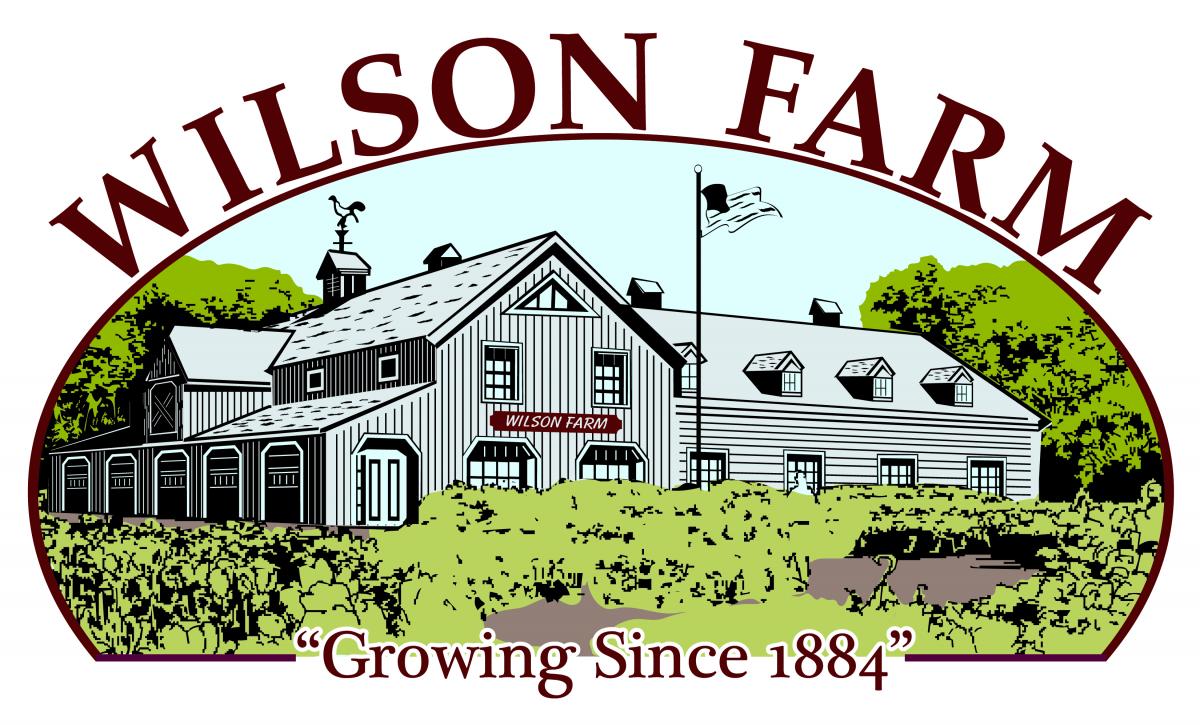To print this issue, either press CTRL/CMD + P or right click on the page and choose Print from the pop-up menu.
Click on images to enlarge.

Crop Conditions
 It’s been gray gray gray out there, punctuated by a few gorgeous sunny days here and there. Crops are growing slowly, in fields and propagation houses alike. Folks are taking advantage of the rare sunny days to cultivate, and of course seeding and planting continues. Potatoes have been planted, brassicas continue to be seeded and transplanted, and tomatoes, peppers, and eggplants are almost ready to be planted out. Many growers are prepping for spring seedling sales, and asparagus is here in full force. Tom Smiarowski of D. A. Smiarowski Farm in Sunderland (and retired UMass Extension Risk Management educator!) has the spring asparagus update for us:
It’s been gray gray gray out there, punctuated by a few gorgeous sunny days here and there. Crops are growing slowly, in fields and propagation houses alike. Folks are taking advantage of the rare sunny days to cultivate, and of course seeding and planting continues. Potatoes have been planted, brassicas continue to be seeded and transplanted, and tomatoes, peppers, and eggplants are almost ready to be planted out. Many growers are prepping for spring seedling sales, and asparagus is here in full force. Tom Smiarowski of D. A. Smiarowski Farm in Sunderland (and retired UMass Extension Risk Management educator!) has the spring asparagus update for us:
In the early part of April we thought that given the weather conditions and soil temps, we would be picking around April 23, which, to the best of my recollection, would be the earliest we ever started picking here in Sunderland/Montague. Then we hit a stretch of cold weather with nights in the upper 20s and that just slowed down the growth tremendously. But it turned out to be a blessing in disguise since most of the spears had not emerged yet, and had they emerged they likely would have been frosted. We started picking on May 1, which is a normal date. I know some growers in Hadley started a few days before us. So far the yield and quality have been fantastic and the taste has been out of this world!
The Massachusetts House of Representatives passed its FY25 budget. See this news item from the Massachusetts Food System Collaborative for a list of food system requests and the funding approved in the House Budget, which includes re-funding of the Food Security Infrastructure Grant Program (FSIG). The Senate is expected to release its budget any day now, to be followed by calls for amendments and debate, providing additional opportunities for advocates to participate in the budgeting process. For more information on the Collaborative and its legislative priorities, see https://mafoodsystem.org/.
Pest Alerts
Alliums
 Onion maggot flies are beginning to emerge across the state—emergence begins at 390 ±103 GDDs base 40°F. See table 1 for current GDD accumulations. With few labeled insecticides, crop rotation is key to managing this pest. If you see symptoms of infestation in your onions or other allium crops this spring, dig up symptomatic plants and look for white maggots in the roots or basal plate. If onion maggots are found, rotate next year’s allium crops far from the infested field.
Onion maggot flies are beginning to emerge across the state—emergence begins at 390 ±103 GDDs base 40°F. See table 1 for current GDD accumulations. With few labeled insecticides, crop rotation is key to managing this pest. If you see symptoms of infestation in your onions or other allium crops this spring, dig up symptomatic plants and look for white maggots in the roots or basal plate. If onion maggots are found, rotate next year’s allium crops far from the infested field.
Brassicas
Imported cabbageworm adults (cabbage whites or ICW) are flying now and will start laying eggs in uncovered brassicas soon. Eggs are oval and ~3 mm long, laid singly, on-end, on the undersides of brassica leaves. ICW is the earliest of the brassica caterpillar pests—it overwinters as pupae in the field, whereas the other brassica caterpillar pests (diamondback moth, cabbage looper, and cross-striped cabbageworm)
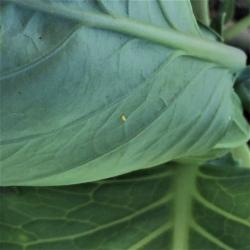 usually don’t overwinter in the Northeast. ICW caterpillars will start hatching in a few weeks. They are green and slightly fuzzy, and camouflage very well along the midrib of brassica leaves. Row cover will prevent egg-laying in crops. If you plan to use pesticides, make sure you have them on-hand now. Labeled conventional products include spinosyns (e.g. Radiant), pyrethroids (e.g. Warrior, Mustang, many others), diamides (e.g. Vetica and Coragen for soil or foliar applications or Exirel and Verimark for soil applications only), Proclaim, Avaunt, and Torac. Diamide products are more expensive but are systemic, have long residuals, and will also protect against flea beetles and cabbage root maggot. Bt products (e.g. Dipel, Xentari) are the most effective OMRI-listed materials. Use a spreader-sticker to help materials adhere to waxy brassica leaves.
usually don’t overwinter in the Northeast. ICW caterpillars will start hatching in a few weeks. They are green and slightly fuzzy, and camouflage very well along the midrib of brassica leaves. Row cover will prevent egg-laying in crops. If you plan to use pesticides, make sure you have them on-hand now. Labeled conventional products include spinosyns (e.g. Radiant), pyrethroids (e.g. Warrior, Mustang, many others), diamides (e.g. Vetica and Coragen for soil or foliar applications or Exirel and Verimark for soil applications only), Proclaim, Avaunt, and Torac. Diamide products are more expensive but are systemic, have long residuals, and will also protect against flea beetles and cabbage root maggot. Bt products (e.g. Dipel, Xentari) are the most effective OMRI-listed materials. Use a spreader-sticker to help materials adhere to waxy brassica leaves.
 Flea beetle pressure remains low, but more beetles will emerge from field edges as the warm weather continues. Protect young transplants with row cover, kaolin clay (e.g. Surround), or an insecticide. Non-waxy brassica crops like bok choy or mustard greens are preferred by flea beetles and can be planted alongside less-preferred waxy brassicas and sprayed regularly to function as a trap crop and reduce sprays to less preferred crops. Many pyrethroids (e.g. Fastac, Baythroid, Brigade, Asana, Danitol, Declare, Warrior, Pounce, Mustang) and neonicotinoids (Venom, Admire Pro, Actara, Platinum) are labeled, as well as Torac (group 21A). Diamides are also labeled (Exirel, Harvanta, Verimark for soil applications)—they have long residuals and will also control caterpillars, cabbage root maggot, and cabbage aphid. Spinosad (e.g. Entrust) is the most effective OMRI-listed product. Use a spreader-sticker to help sprays stick onto waxy brassica leaves.
Flea beetle pressure remains low, but more beetles will emerge from field edges as the warm weather continues. Protect young transplants with row cover, kaolin clay (e.g. Surround), or an insecticide. Non-waxy brassica crops like bok choy or mustard greens are preferred by flea beetles and can be planted alongside less-preferred waxy brassicas and sprayed regularly to function as a trap crop and reduce sprays to less preferred crops. Many pyrethroids (e.g. Fastac, Baythroid, Brigade, Asana, Danitol, Declare, Warrior, Pounce, Mustang) and neonicotinoids (Venom, Admire Pro, Actara, Platinum) are labeled, as well as Torac (group 21A). Diamides are also labeled (Exirel, Harvanta, Verimark for soil applications)—they have long residuals and will also control caterpillars, cabbage root maggot, and cabbage aphid. Spinosad (e.g. Entrust) is the most effective OMRI-listed product. Use a spreader-sticker to help sprays stick onto waxy brassica leaves.
Cabbage root maggot: We are at or just past peak flight for CRM across the state, so we expect to start seeing damage from the earliest flies soon. As the maggots feed on crop roots, plants will wilt and become stunted, and foliage often turns pink and purple. Crops that are infested early on will likely die. Dig up suspect plants and look for white maggots and/or brown pupae, both ~1 cm long, within the roots. In turnips and radishes, maggots will tunnel within the roots, rendering crops unmarketable. Egg laying will continue for another week or two, so if you have infested crops, plan to protect them with row cover or an insecticide. Soil drenches of Coragen (chlorantraniliprole) or Verimark (cyantraniliprole) are labeled for leafy and root brassica crops and may be applied at planting. Radiant (spinetoram) and Entrust (spinosad, OMRI-listed) are both only labeled for use on leafy brassicas and may be applied at planting and in up to 2 additional applications. Other labeled materials include bifenthrin (Capture, Sniper LFR, Brigade – head and stem brassicas), diazinon (specific crops only), Mustang Maxx (root brassicacs), and Azera (all brassicas).
Chenopods
 Spinach leafminer: We are keeping an eye out for the first leafminer eggs in spinach, chard, and beets—none yet! Leafminers feed within the leaves of these crops, causing unsightly tunnels. Eggs are ~2 mm long and look like tiny grains of rice. They are laid on their sides on the undersides of leaves, in neat rows. This pest overwinters as pupae in the soil of fields that were infested in the fall, so keep an eye out for eggs and tunnels in any chenopods planted nearby last year’s infested crops. For conventional growers, group 5 (e.g. Radiant) and group 28 (e.g. Coragen, Exirel) materials are labeled for use on spinach, chard, and beets, and have translaminar activity to target larvae that have already tunneled between leaf layers. Blackhawk is labeled for use on beets only. Brigade 2EC (spinach only) and permethrin (e.g. Pounce, Perm-Up, Loveland Permethrin – spinach and chard only) or pyrethrins (e.g. Pyganic, Pyrenone, Pyronyl) can be applied preventatively, before a crop becomes infested. Pyrethrins are highly light sensitive and would need to be reapplied frequently. For organic growers, Entrust plus a spreader-sticker to aid in leaf penetration is the best chemical control option.
Spinach leafminer: We are keeping an eye out for the first leafminer eggs in spinach, chard, and beets—none yet! Leafminers feed within the leaves of these crops, causing unsightly tunnels. Eggs are ~2 mm long and look like tiny grains of rice. They are laid on their sides on the undersides of leaves, in neat rows. This pest overwinters as pupae in the soil of fields that were infested in the fall, so keep an eye out for eggs and tunnels in any chenopods planted nearby last year’s infested crops. For conventional growers, group 5 (e.g. Radiant) and group 28 (e.g. Coragen, Exirel) materials are labeled for use on spinach, chard, and beets, and have translaminar activity to target larvae that have already tunneled between leaf layers. Blackhawk is labeled for use on beets only. Brigade 2EC (spinach only) and permethrin (e.g. Pounce, Perm-Up, Loveland Permethrin – spinach and chard only) or pyrethrins (e.g. Pyganic, Pyrenone, Pyronyl) can be applied preventatively, before a crop becomes infested. Pyrethrins are highly light sensitive and would need to be reapplied frequently. For organic growers, Entrust plus a spreader-sticker to aid in leaf penetration is the best chemical control option.
Sweet corn
European corn borer: We’re still a ways away from ECB emergence (374 GDDs base 50°F) in MA—see table 1. See the article in this issue for information on how to use pheromone traps to monitor for ECB and the other sweet corn caterpillar pests.
Miscellaneous/Multiple Crops
 Seedcorn maggot: We are past peak flight for seedcorn maggot across the state and crop damage is likely still occurring in large-seeded crops like peas, beans, and sweet corn. Seedcorn maggots will feed on seeds before they emerge, resulting in poor stand. Other pests and diseases, including wireworms and damping off, can also prevent seedlings from emerging; check for maggots and feeding tunnels inside seeds or stems to confirm what pest you’re dealing with. Insecticide treatments are only effective if applied preventatively, so make a note to apply next year at planting if you had bad damage this spring. See the appropriate crop section of the New England Vegetable Management Guide for labeled insecticides.
Seedcorn maggot: We are past peak flight for seedcorn maggot across the state and crop damage is likely still occurring in large-seeded crops like peas, beans, and sweet corn. Seedcorn maggots will feed on seeds before they emerge, resulting in poor stand. Other pests and diseases, including wireworms and damping off, can also prevent seedlings from emerging; check for maggots and feeding tunnels inside seeds or stems to confirm what pest you’re dealing with. Insecticide treatments are only effective if applied preventatively, so make a note to apply next year at planting if you had bad damage this spring. See the appropriate crop section of the New England Vegetable Management Guide for labeled insecticides.
| Table 1. Growing degree day accumulation, jan 1 - may 8, 2024 | ||
|---|---|---|
| Location |
GDD (base 40°F) Cabbage, onion & Seedcorn maggots |
GDD (base 50°F) Sweet Corn caterpillars |
| Western MA | ||
| Deerfield | 494 | 122 |
| Westfield Arpt | 563 | 147 |
| Chicopee Falls | 553 | 137 |
| South Deerfield | 538 | 135 |
| Central MA | ||
| Leominster | 465 | 92 |
| Northbridge | 493 | 101 |
| Worcester | 498 | 108 |
| Eastern MA | ||
| Bolton | 480 | 92 |
| Stow | 476 | 86 |
| Lawrence Arpt | 463 | 78 |
| Ipswich | 501 | 74 |
| East Bridgewater | 542 | 94 |
| Boston | 537 | 100 |
| New Bedford Arpt | 560 | 88 |
Contact Us
Contact the UMass Extension Vegetable Program with your farm-related questions, any time of the year. We always do our best to respond to all inquiries.
Vegetable Program: 413-577-3976, umassveg@umass.edu
Staff Directory: https://ag.umass.edu/vegetable/faculty-staff
Home Gardeners: Please contact the UMass GreenInfo Help Line with home gardening and homesteading questions, at greeninfo@umext.umass.edu.
Pheromone Trapping for Sweet Corn Caterpillar Pests
One of the biggest challenges in sweet corn production is caterpillar damage and the presence of caterpillars in ears. The best tactic for managing these pests involves a combination of trapping using pheromone lures and scouting to determine the optimal times to spray your crop. Spraying based on trapping and scouting information, as opposed to spraying on a strict calendar schedule, can reduce the number of sprays going on a crop, saving growers time and money.
There are 3 major caterpillar pests of sweet corn in New England – European corn borer, corn earworm, and fall armyworm. European corn borer is the earliest of these to show up in the Northeast. All three species can be present in a corn field at once.
A brief overview of the 3 major corn caterpillar pests:

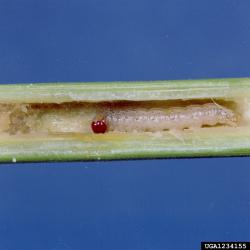 European corn borer (ECB) is the first corn caterpillar pest to show up in sweet corn, as they overwinter in the Northeast. Adult moths emerge later in May, at 375 GDD base 50°F. (GDDs in MA range from 74 to 147 as of Wednesday.) Eggs are laid on undersides of leaves and caterpillars bore into the corn tassel, stalk, directly into the ear, or enter ears through the silk channel. The earliest signs of ECB infestation will be shot-hole damage in leaves or lodged tassels, accompanied by lots of tan-colored frass. There are two generations of caterpillars per year. There are two strains of ECB – a NY strain and an IA strain – as well as a hybrid of the two strains. All 3 are trapped separately using specific lures.
European corn borer (ECB) is the first corn caterpillar pest to show up in sweet corn, as they overwinter in the Northeast. Adult moths emerge later in May, at 375 GDD base 50°F. (GDDs in MA range from 74 to 147 as of Wednesday.) Eggs are laid on undersides of leaves and caterpillars bore into the corn tassel, stalk, directly into the ear, or enter ears through the silk channel. The earliest signs of ECB infestation will be shot-hole damage in leaves or lodged tassels, accompanied by lots of tan-colored frass. There are two generations of caterpillars per year. There are two strains of ECB – a NY strain and an IA strain – as well as a hybrid of the two strains. All 3 are trapped separately using specific lures.
- Corn earworm (CEW) has not historically overwintered in the Northeast, but there

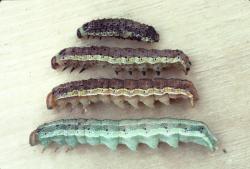 are now small overwintering populations that have been detected in parts of NY. None of our trapping sites in MA have detected overwintering populations. Most CEW blow in on storms coming from the South or from overwintered populations in western NY, arriving in mid-July. Eggs are laid in fresh silks and caterpillars enter the ear through the silk channel. There are two generations of CEW per year.
are now small overwintering populations that have been detected in parts of NY. None of our trapping sites in MA have detected overwintering populations. Most CEW blow in on storms coming from the South or from overwintered populations in western NY, arriving in mid-July. Eggs are laid in fresh silks and caterpillars enter the ear through the silk channel. There are two generations of CEW per year. - Fall armyworm (FAW) is also blown northward on storms, usually arriving in the Northeast in mid-July. Eggs are laid preferentially in whorl-stage corn, and caterpillars create large, ragged holes in the leaves and drop big
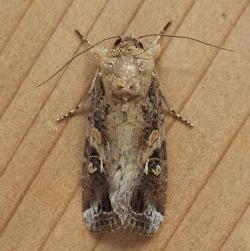
 clumps of frass.
clumps of frass.
See our Identifying Caterpillars in Sweet Corn article for more information on each of these pests.
What is pheromone trapping?
Pheromones are chemicals produced by organisms to communicate with one another. Pheromones from one species can usually only be detected by that species. There are many different types of pheromones that insects use, but the most common type is the sex pheromone. Usually, females will emit a tiny amount of a chemical that attracts the male and increases the likelihood of mating. These sex pheromones are volatile, meaning they easily evaporate into gaseous form at daytime summer air temperatures, so they are carried on air currents and intercepted by receptors on the males’ antennae. The males then fly upwind to find the source of the pheromone—a prospective mate.
 The chemical compositions of pheromones for a number of pest species have been identified and can be synthesized in the laboratory. These synthetic pheromones can be used in conjunction with traps to catch adult male insects. Extension networks throughout the Northeast use pheromone-baited traps to monitor ECB, CEW, and FAW, as well as squash vine borer, a pest of cucurbits. Traps are set up in active sweet corn fields and are checked weekly for moths. The pheromone lures are changed regularly.
The chemical compositions of pheromones for a number of pest species have been identified and can be synthesized in the laboratory. These synthetic pheromones can be used in conjunction with traps to catch adult male insects. Extension networks throughout the Northeast use pheromone-baited traps to monitor ECB, CEW, and FAW, as well as squash vine borer, a pest of cucurbits. Traps are set up in active sweet corn fields and are checked weekly for moths. The pheromone lures are changed regularly.
These traps are valuable tools for monitoring, and while they do intercept some number of moths, they do not provide effective control of sweet corn pests on their own. For all three corn caterpillar pests, pheromone trap captures tell us when each pest has emerged or arrived in that field. For ECB and FAW, the trap captures tell us when to begin scouting a corn crop for eggs and caterpillars, and the decision of whether or not to spray is made from scouting results. For more information on scouting for corn caterpillar pests, see our Managing Sweet Corn Pests Through Scouting & Pheromone Trapping article and the UMass Sweetcorn Insect Management Field Scouting Guide. We publish trap counts from sites across the state weekly in the Pest Alerts section of Veg Notes, so if you aren’t trapping on your farm, you can use trap counts from the location nearest to you to tell you when to begin scouting your corn. Once CEW arrives in the region, and trap counts exceed 1.4 moths/week, spray schedules are determined by CEW trap counts, with higher counts triggering tighter spray schedules (see Table 1).
|
Table 1. Spray Intervals for Corn Earworm based on moth captures in Heliothis net traps. |
|
|---|---|
|
Moths/Night |
Spray Interval |
|
0 - 0.2 |
no spray |
|
0.2 -0.5 |
6 days |
|
0.5 - 1 |
5 days |
|
1 - 13 |
4 days |
|
Over 13 |
3 days |
There are two types of traps commonly used for corn pest pheromone trapping:
- Scentry Heliothis net traps are used to monitor ECB, CEW, and squash vine borer. (Heliothis is a genus of moths that CEW used to belong to – the species has now been reclassified as part of the genus Helicoverpa but the trap name remains the same!) Heliothis traps are tied to a pole, with the bottom of the trap drawn wide. The pheromone lure is clipped to a string at the bottom mouth of the trap. Moths are attracted to the lure then fly up into the top portion of the trap—a behavior which would help them find their prospective mate in the field—and are trapped.
- Universal Moth Traps, or bucket traps, are used for monitoring FAW, among many other insects. The pheromone lures are placed in a compartment beneath the trap lid, and VaporTape (a
 small PVC strip containing the insecticide dichlorvos) is placed in the bucket. Don’t forget to use gloves with the VaporTape! Bucket traps come in green or yellow and white – yellow and white traps have been found to catch loads of bumble bees and other pollinators, so we prefer using the green traps for FAW.
small PVC strip containing the insecticide dichlorvos) is placed in the bucket. Don’t forget to use gloves with the VaporTape! Bucket traps come in green or yellow and white – yellow and white traps have been found to catch loads of bumble bees and other pollinators, so we prefer using the green traps for FAW.
To get the most from your pheromone traps, they must be used properly:
- Place the traps and the pheromones out before you would normally expect the adult insect to be active. That way, you can be sure to catch the first adult flight and get an early warning that adults are present in your field, laying eggs that will soon hatch into larvae that cause crop damage. See Table 2 for information about when you should set up traps for different pests.
- Keep lures frozen or at least refrigerated until ready for use. If you keep them on the dashboard of your truck, they won’t work well when you place them in the trap.
- When handling pheromone lures or VaporTape, do not touch them with your hands. Use a pair of forceps or wear latex gloves. This is especially important when you are using pheromones for more than one pest. Contamination of a lure with another pheromone will likely reduce the effectiveness. VaporTape is insecticidal tape and shouldn’t be touched with bare skin.
- Make a schedule of when to change lures. See Table 2 for information about how often to replace lures for different pests.
- Check traps weekly, on the same day every week.
|
Table 2. Trapping information for various pests |
||||
|---|---|---|---|---|
|
Pest |
Trap # and type |
Trap setup |
Trapping Dates |
Lure replacement interval |
|
ECB |
2 white Heliothis traps (1 for NY, 1 for IA) |
Place traps at least 50 ft apart, in weedy border of field. Bottom opening should be level with top of weeds. |
May 15 (even if corn isn’t up yet) – September 15 |
4 weeks |
|
CEW |
2 white Heliothis traps |
Trap in silking corn. Move one trap into a block with fresh silk each week. |
July 15, or as soon as you have silking corn – September 15 |
2 weeks |
|
FAW |
1 green bucket trap |
Hang trap at plant height on metal stake. Place at edge of field in whorl-stage corn. Place lure in cage and VaporTape in bucket. |
July 15 – September 15 |
4 weeks. Vaportape will last the entire season. |
|
SVB |
1 white Heliothis trap |
Place trap in-row with squash. Bottom opening should be directly above the plant canopy. |
June 1 – October 1 |
4 weeks |
Commercial growers: If you’d like to begin trapping for corn pests on your farm, we can help get you started! Contact us at umassveg@umass.edu or 413-577-3976.
Here are some, but certainly not all, suppliers of pheromone trapping materials. Different brands of lures are available for each pest – use the same brand over the course of a season to get consistent trap counts.
- Alpha Scents, Inc. 503-342-8611
- Gempler’s 800-382-8473
- Great Lakes IPM 517-268-5693
- Insects Limited Inc. 317-896-9300
- Pacific Biocontrol Corporation 800-999-8805
- Scentry Biologicals Inc. 800-735-5323
- Trece Incorporated 866-785-1313
For management recommendations, see the Corn section of the New England Vegetable Management Guide or this article on Corn Earworm Management.
--UMass Vegetable Program
Extending Lettuce Production Into the Summer
--Written by Emmalea Ernest, Extension Fruit & Vegetable Specialist. Originally Published in Delaware Cooperative Extension Weekly Crop Update 32:7, April 26, 2024.
Lettuce is an important crop for direct market and restaurant sales. In Delaware, lettuce production is typically constrained to the spring and fall since high temperatures can induce premature flowering (bolting) and development of bitter flavor in lettuce. However, I have been testing combinations of practices that might allow for lettuce production in the summer also. Over several seasons, I have tested three strategies for maintaining quality lettuce for summer production: use of heat tolerant varieties, use of shade cloth and use of white and silver plastic mulch. I have also tested using these strategies in combination. All the trials were conducted at University of Delaware’s research farm in Georgetown, Delaware.
Heat Tolerant Varieties
 In all of the trials I have done, variety is the most significant factor determining premature bolting and development of bitter flavor. Some varieties are slow to bolt but still develop bitter flavor. In 2023 I tested 14 lettuce varieties that were reported to be heat tolerant for performance with early and late June planting dates. This trial was transplanted into white plastic mulch and shaded with 30% black shade cloth.
In all of the trials I have done, variety is the most significant factor determining premature bolting and development of bitter flavor. Some varieties are slow to bolt but still develop bitter flavor. In 2023 I tested 14 lettuce varieties that were reported to be heat tolerant for performance with early and late June planting dates. This trial was transplanted into white plastic mulch and shaded with 30% black shade cloth.
The bitterness ratings from the June 5 planting, which was harvested in early July are in Table 1.
Bitterness was rated on a 1-4 scale with ratings of 1 and 2 considered marketable and ratings of 3 and 4 considered unmarketable. The varieties with the lowest bitterness ratings were Skyphos, Muir, Nevada, Jericho, Salanova Red Tango, and Sunland. In the June 22 planted trial, harvested in early August, only Muir and Nevada produced marketable lettuce.
| Table 1. flavor ratings for lettuce varieties transplanted june 5 and harvested early july | ||
|---|---|---|
| variety name | type | average flavor rating* |
| Skyphos | Butterhead, Red | 1.04 a** |
| Muir | Batavia, Green | 1.08 ab |
| Nevada | Batavia, Green | 1.13 abc |
| Jericho | Romaine | 1.17 abc |
| Salanova Red Tango | One-Cut, Red | 1.33 abc |
| Sunland | Romaine | 1.38 abc |
| Salanova Red Butter | One-Cut, Red | 1.42 bcd |
| Verigo | One-Cut, Green | 1.46 cde |
| Rubygo | One-Cut, Red | 1.75 def |
| Salanova Green Oakleaf | One-Cut, Green | 1.79 efg |
| Adriana | Butterhead, Green | 1.92 fg |
| Starfighter | Leaf, Green | 2.04 fg |
| Salanova Green Butter | One-Cut, Green | 2.13 g |
| Red Cross | Butterhead, Red | 3.21 h |
| *Flavor was rated on a 1-4 scale with ratings 1 and 2 having marketable flavor and 3 and 4 being unmarketable. **Averages followed by the same letter are not statistically different from one another. | ||
Light Colored Mulch
In 2023 I tested the effect of silver and white plastic mulch on lettuce yield and quality. A bare ground treatment and a black plastic mulch treatment were included as controls. Silver mulch produced the largest lettuce plants and the least bitter lettuce. White mulch also improved lettuce flavor, but not as much as silver. Silver or white mulch did not completely overcome the effect of variety, however. Heat sensitive varieties still bolted and became bitter on silver and white mulch. You cannot produce marketable lettuce under hot conditions if you are not also using a heat tolerant variety.
Shade Cloth
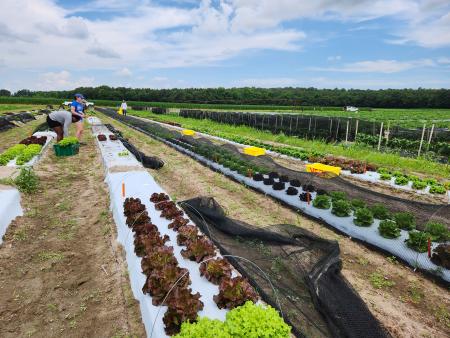 In trials planted in 2018 and 2019, use of 30% black shade cloth reduced bitterness in lettuce, however these trials were planted in early April and harvested in early June. In the 2023 trials, which were planted in June and harvested in July and August, 30% black shade cloth decreased lettuce plant size and had no effect on bitterness. In all of these trials, shade cloth was applied over low tunnels, which may have a heat trapping effect. Shade cloth might be more effectively used to reduce air temperatures for lettuce crops grown in high tunnels.
In trials planted in 2018 and 2019, use of 30% black shade cloth reduced bitterness in lettuce, however these trials were planted in early April and harvested in early June. In the 2023 trials, which were planted in June and harvested in July and August, 30% black shade cloth decreased lettuce plant size and had no effect on bitterness. In all of these trials, shade cloth was applied over low tunnels, which may have a heat trapping effect. Shade cloth might be more effectively used to reduce air temperatures for lettuce crops grown in high tunnels.
Conclusions
If you want to try producing lettuce for harvest in July and August, using an extremely heat tolerant variety is vital. Nevada and Muir are the two varieties I have tested with the most heat tolerance. I am testing additional varieties in 2024, and hoping to identify more that are very heat tolerant. Using white or silver plastic mulch can also help reduce bolting and bitterness in summer lettuce. Silver mulch has some additional bitterness reduction and growth promotion advantages over white mulch. However, silver mulch also costs more and is not fun to work around on sunny days. Shade cloth (30% black) on low tunnels did not increase marketable yield in summer lettuce and is probably not worth the cost and trouble in this production system.
FSMA Final Rule on Agricultural Water Released
Last week, the FDA released its final rule on agricultural water for growers subject to inspection under the Food Safety Modernization Act’s Produce Rule. The revised rule replaces the original requirements for preharvest water only. The original Produce Rule required growers to create a microbial water quality profile for each of their water sources by taking several tests of the water for generic E. coli, an indicator of fecal contamination. The new Rule does not require routine water testing but instead requires growers to do a written agricultural water assessment for each water source at least once annually. The assessment should consider factors including water use practices, crop characteristics, environmental conditions, potential impacts on water from adjacent and nearby land, and other relevant factors.
Compliance dates are based on the size of the farm—the largest farms (those averaging more than $500,000 in gross sales over the last 3 years) will have to begin complying on April 7, 2025. Smaller farms will have an additional one or two years to comply, depending on their total sales amounts.
The rules for postharvest water have not changed and inspections began this year for the largest farms. Growers using untreated ground water for postharvest activities—e.g., produce washing, cleaning of food contact surfaces, handwashing, or ice making—must test the water to make sure it’s free of generic E. coli, at least 4 times in the first year and then 1 time every year after that. If any test is positive for E. coli, another 4 tests per year are required until all tests are negative.
The FDA is hosting a webinar on the changes to the Rule on Agricultural Water on Monday, May 20, 2024, 1-2 pm.
Register at: FSMA Final Rule on Pre-Harvest Agricultural Water Webinar
UMass Extension will provide training and support to affected growers as they prepare to comply with this new rule. Stay tuned for more information, including about upcoming trainings and other events. In the meantime, if you have questions about produce safety or the Produce Safety Rule reach out to Lisa McKeag at lmckeag@umass.edu or 413-658-8631.
News
Preserve the Valley: Western MA Food Processing Center & MA Ag Innovation Center
Interested in selling value-added products at your farm stand, through your CSA, or at wholesale? Check out the Western MA Food Processing Center’s updated Preserve the Valley program! Farmers deliver the key ingredients to Greenfield and our team will process, bottle, label and pack, providing the additional ingredients, jar, lid, label and case—all for a flat fee. Summer 2024 processing slots are filling up fast—learn more at WMFPC.org. And don’t forget to check out the MA Ag Innovation Center for value-added enterprise planning support. We can also help you develop your own products!
New Entry Survey: Local Food Marketing Channels, Food Hubs & Value-Added Production
The New Entry Sustainable Farming Project is conducting a study of small-scale producers’ decisions related to selling to food hubs or other aggregation channels and producing value-added products. This study is part of their USDA Local Food Promotion Project. They are looking for New England / Northeast farmers operating 10 acres or less that are willing to fill out a two-part survey about their business in 2022 and 2023. By answering all of the survey questions and providing information for both 2022 and 2023, participants will receive a $50 Visa gift card.
If you are interested in participating, you can find the survey here: Link to Survey. For more information about the study visit the website at New Entry Food Hub Research Study. The study team can provide technical/translation assistance to complete the survey, if needed.
Questions? Contact Anna Ruiz, anna.rz.tufts@gmail.com
URI Laser Scarecrows Available
Research at the University of Rhode Island, Cornell Cooperative Extension, and the University of Florida/USDA-APHIS National Wildlife Research Service has shown that the use of automated lasers can significantly reduce bird damage to sweet corn.
The URI Laser Scarecrow Project is making experimental devises available to growers who want to try the technology on their farms. Fully assembled scarecrows are available for $800 each to participating farmers. A single unit has a protection radius of 300-500 ft for sweet corn. Preference will be given to sweet corn growers but the scarecrows can be used in other crops.
For more information or to request a scarecrow, contact Dr. Rebeca Brown at brownreb@uri.edu or 401-874-2755, or visit laserscarecrow.info.
MDAR Grant Programs Currently Open
Agricultural Food Safety Improvement Program (AFSIP)
The Agricultural Food Safety Improvement Program (AFSIP) is a reimbursement grant program that supports produce and aquaculture operations that are looking to improve their food safety practices that work towards minimizing the risks of microbial contamination and food-borne illnesses while increasing market access.
Participants selected for funding are provided with reimbursement grants for 80% of total project costs up to $50,000.
Applications Due: 4:00pm on Friday, May 24, 2024.
Contact: Laura Maul at Laura.Maul@mass.gov or 857-507-5972
Climate Smart Agriculture Program (CSAP)
The Climate Smart Agriculture Program links MDAR's water, energy, and climate grants together into one application. This includes the Agricultural Climate Resiliency & Efficiencies (ACRE) Program, the Agricultural Environmental Enhancement Program (AEEP), and the Agricultural Energy Grant Program (ENER). This program continues the goals of the three individual grants by implementing projects that help the agricultural sector adapt to climate change, mitigate climate change, reducing or preventing impacts to natural resources that may result from agricultural practices, and that improve energy efficiency and facilitate adoption of alternative clean energy technologies.
The CSAP grant is broken into two sections.
- Section I: Environment is for environmental projects such as soil health, water use efficiency, or other projects working towards reducing or limiting greenhouse gas emissions.
- Section II: Energy is Ag-Energy projects to improve energy efficiency or to facilitate clean energy adoption.
Applicants can apply to either or both sections.
Participants selected for funding under either section are provided with reimbursement grants for 80% of total project costs up to $50,000.
Applications Due: 4:00pm on Friday, May 31, 2024.
Contacts:
- Section I: Environment - Laura Maul at Laura.Maul@mass.gov or 857-507-5972
- Section II: Energy - Gerry Palano at Gerald.Palano@mass.gov or 617-571-4969
Events
FDA Webinar on the FSMA Final Rule on Pre-Harvest Agricultural Water
When: Monday, May 20, 2024, 1-2pm
Where: Zoom
Registration: Click here to register.
The U.S. Food & Drug Administration (FDA) will hold an informational webinar on Monday, May 20, 2024, 1-2pm on the recently released Standards for the Growing, Harvesting, Packing, and Holding of Produce for Human Consumption Relating to Agricultural Water (Agricultural Water Final Rule) issued under the FDA Food Safety Modernization Act (FSMA). During the webinar, the FDA will provide an overview of the final rule and answer pre-submitted questions as well as take live questions.
Twilight Meeting at Tangerini's Farm
When: June 12, 2024, 4-7pm - free childcare available!
Where: Tangerini's Spring Street Farm,139 Spring Street, Millis, MA, 02054
Registration: Free! Please register in advance, for food ordering purposes. Click here to register.
Join Tangerini Farm, the UMass Extension Vegetable Program and SEMAP for a twilight meeting!
- Steve Chiarizio of Tangerini Farm will describe the new tile drainage system and bioreactor that they installed at the farm last year with the help of Massachusetts FSIG funding. A representative from Alleghany Services, who installed the system, will also be on-hand to answer questions.
- Maria Gannett, UMass Extension Weed Specialist, and Sue Scheufele, UMass Extension Vegetable IPM Specialist, will talk about sweet corn weed and insect pest management options.
Presentations 4-6 pm, followed by a light supper.
Program co-sponsored by UMass Extension and the Southeastern Massachusetts Agricultural Partnership (SEMAP)
Pesticide recertification credits TBD
Transition to Organic Partnership Program: Brookfield Farm Field Walk
When: Tuesday, June 25, 2024, 4-7pm
Where: Brookfield Farm, 24 Hulst Rd., Amherst, MA 01002
Registration: Free! Please register in advance, for food ordering purposes. Click here to register.
Join Brookfield Farm, the UMass Extension Vegetable Program and NOFA/Mass for a twilight meeting!
- Kerry and Max Taylor from Brookfield Farm will describe the new well they installed last year that includes a solar pump. The well was installed with support from NRCS.
- Sue Scheufele, UMass Extension Vegetable IPM Specialist, will lead a field walk and pest scouting demonstration.
- Maria Gannett, UMass Extension Weed Specialist, will lead a weed walk and discuss weed ID, organic weed management, and the relationship between weeds and soil health.
Presentations 4-6 pm, followed by a light supper.
Vegetable Notes. Maria Gannett, Genevieve Higgins, Lisa McKeag, Susan Scheufele, Alireza Shokoohi, Hannah Whitehead, co-editors. All photos in this publication are credited to the UMass Extension Vegetable Program unless otherwise noted.
Where trade names or commercial products are used, no company or product endorsement is implied or intended. Always read the label before using any pesticide. The label is the legal document for product use. Disregard any information in this newsletter if it is in conflict with the label.
The University of Massachusetts Extension is an equal opportunity provider and employer, United States Department of Agriculture cooperating. Contact your local Extension office for information on disability accommodations. Contact the State Center Directors Office if you have concerns related to discrimination, 413-545-4800.
